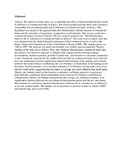| dc.description.abstract | Abstract
The objective of this study was to determine the effect of financial liberalization on the X-efficiency of commercial banks in Kenya. The study hypothesized that there exists a positive relationship between liberalization and X-efficiency of commercial banks in Kenya. This hypothesis was based on the argument that after liberalization with the increase in commercial banks and the relaxation of regulations, competition would intensify. This in turn would force commercial banks to be more efficient. The key research question was: “Did liberalization improve the X- efficiency of commercial banks in Kenya?” The study used secondary data that was obtained from the audited financial statements of the commercial banks as well as the Banks’ Supervision Department of the Central Bank of Kenya (CBK). The sample period was 1986 to 2007. The analysis was based on stochastic cost frontier analysis approach.
The key findings of the study are as follows: First, after financial liberalization, commercial banks had put in place cost intensive measures to enhance their outputs (profits) through strategic developments, branch expansion, growth of capital base, and measures to encounter competitive rivalry. During the same period, the sudden observed shift by commercial banks away from the best cost optimization frontier implied that financial liberalization of the banking sector hardly achieved the desired effects of enhancing the cost efficiency of institutions in the banking sector. Secondly, the three periods’ cross-sectional estimates of X-efficiency for big banks were lower than for small banks, suggesting that big banks as a group were more efficient than small banks. Thirdly, the findings based on the Pearson's correlation coefficient measure of persistence indicated that a significant linear relationship existed between X-efficiency and Financial Liberalization. Finally, the findings indicated that the average cost efficiency estimates were significantly different between the post-financial liberalization period and the pre- and during liberalization. In conclusion, financial liberalization in Kenya led to a decline in cost efficiency across the sampled banks. The findings are in agreement to previous studies by Sakina (2006) and Grifell-Tatje and Lovell (1996). | en |

